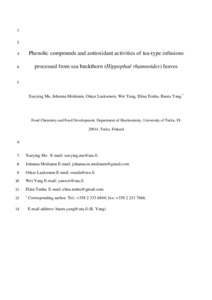Phenolic compounds and antioxidant activities of tea-type infusions processed from sea buckthorn (Hippophaë rhamnoides) leaves
Xueying Ma; Johanna Moilanen; Oskar Laaksonen; Wei Yang; Elina Tenhu; Baoru Yang
https://urn.fi/URN:NBN:fi-fe2021042821475
Tiivistelmä
Sea buckthorn (Hippophaë rhamnoides, SB) leaves contain wide-ranging bioactive compounds. Processing of the leaves into beverages/food presents great potential for supporting human health. The research aimed to investigate the impact of different processing methods on phenolic compounds and antioxidant activities of tea type infusions prepared from SB leaves. Leaves of two SB cultivars, ‘Terhi’ and ‘Tytti’, were processed with different methods commonly used for tea processing. Phenolic compounds in the infusions were analyzed with High-Performance Liquid Chromatography-Diode-Array Detection and High-Performance Liquid Chromatography Electrospray Ionization-Tandem Mass Spectrometry. Isorhamnetin-3-O-glucoside-7-O-rhamnoside, isorhamnetin-3-O-rutinoside and kaempferol-3-O-hexoside-7-O-rhamnoside were the three major flavonol glycosides, stachyurin and casuarinin were the most abundant ellagitannins. The infusions of ‘Tytti’ contained more total phenolics than those of ‘Terhi’ (p < 0.05). High temperature processing resulted in higher content of total phenolics and ellagitannins in the infusions compared with low temperatures (p < 0.05). Thermal processing decreased the antioxidant activities of the infusions.
Kokoelmat
- Rinnakkaistallenteet [27094]
